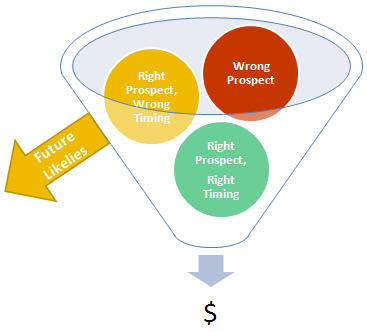http://www.crmbuyer.com/story/Is-the-Ship-Really-Sinking-B2B-Budgeting-for-Post-Slump-Growth-65547.html. In it, there's a stat that very few of us in B2B marketing will find surprising:
"Aberdeen research that suggested that upwards of 60 percent to 70 percent of
leads are never followed up by sales."
This is a horrific number when you consider the investments being made in order to generate these leads. Sales is commission-driven, so if they are not following up with your leads, it's likely because the leads are not turning into revenue for them.
In most cases, the problem is not that the leads being passed over to sales are inherently bad leads, in many cases they may be executives, in the right role, at companies of the right size in the right industries. The problem is that they are not currently in a buying process, and therefore are not interested in interacting with your sales team at the moment. If you've been sending this type of lead to sales for a while, it won't be a surprise to see that they don't follow up with the leads they receive.

The solution to this problem is in differentiating between a "good prospect" and a "good prospect who's interested". This comes down to looking at inbound interest level and web activity to determine whether it appears that they are the right executive in a buying cycle, or just the right executive.
It is often the case that a large number of your leads, fall into the category of "future likelies". They are the right executive, in the right role, at the right company, but you don't see the activity patterns that indicate buying interest. Nobody benefits by sending future likelies over to sales. Both your sales team and the prospect will be frustrated by a sales call where there is no buying process happening.
Instead, future likelies need to be nurtured (see post on Nurturing here: http://digitalbodylanguage.blogspot.com/2008/12/nurture-marketing-vs-pachinko.html). Provide them with education on the market, your solutions, things that educate them and add value to their day. When a buying event happens (and with good lead scoring, you will see the signs of that buying event), you will be top of mind with them and can then get your sales team involved.






2 comments:
You're right. The more you send leads to sales that are not ready, there's a greater chance that leads will not be contacted. We have attempted to remedy this creating a lead gen team that all they do is dial and qualify.
Our lead gen reps can each get through about 300 dials a day on the dialer, whereas sales was only making about 75 calls. The commission structure is different. You incentivise lead gen to dial and sales to sell.
Darin, thanks for the comment. Agreed that a lead gen team is in a better position to dial and qualify than field reps. Even a lead gen team can drive their calling off of a qualification score on the leads based on their online behaviour.
Compensation is an interesting point - people do what their paid to do, and if you comp based on number of calls, you'll get lots of calls. Comping based on leads that field sales accepts, and you'll get much selective calling behaviour.
Post a Comment